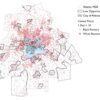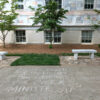For the second year in a row this past May, a group of Atlantans have walked around the City together, stopping on occasion to listen to speakers with megaphones.
These events aren’t annual political marches, they’re just Jane’s Walks. But who is Jane, and why are we walking for her?
Jane’s Walk is a non-profit organization that works with communities to organize free, educational walks each May 5th to 7th commemorating Jane Jacobs, the urban activist and author of The Death and Life of Great American Cities.1
Widely considered the gospel for contemporary urban planning practices, the book was groundbreaking when it was first published in 1961, upending the urban planning profession. In the book, Jacobs, herself not a planner, emphasized the importance of observing the ways that real people behaved in urban environments, as compared to how quickly cars could theoretically move through them. She witnessed the decisions that led to the decline of urban neighborhoods and deduced how to design spaces that attract more people. The purpose of these walks is to emulate Jacobs’ practices of honest observation, questioning, and reimagining of places, not from a staunchly professional perspective, but through the diverse lenses of the people who actually inhabit those communities.
“So Much to Discuss”: Walking through Downtown and Midtown
When we organized the first Jane’s Walk through Downtown Atlanta last year, I didn’t expect nearly one hundred people to come out on a hot May day. But the people who met us by Woodruff Park’s fountain wall were excited and eager to walk. Their energy was palpable as we set off, heading east down Auburn Avenue towards the first stop of the walk by the Atlanta Life Insurance building. The speakers – a mix of advocates, planners, and local historians – and I had developed a route approximately 3 miles long, which started at the northern end of Woodruff Park and looped around the central core of Downtown. We stopped at parks and plazas to discuss architecture, the quality of the streets and sidewalks, and the history of our locations. The group was so large and had so much to discuss that after two hours, we had only made it through two thirds of the route. While some participants had dropped off along the way and many others had to go by then, remarkably the majority of the group walked with us for another hour through South Downtown to Underground Atlanta.
This year, we walked through Midtown Atlanta in order to take a closer look at how the city is changing and how Midtown Alliance has been instrumental in shaping the rapid rate of development. The attendees this year were more diverse than last year in terms of age, race, ability, and communities represented, with some coming from as far as Chamblee and Stone Mountain Village. Many had lived in Midtown in decades past and remarked at seeing it change all over again. Walking down Midtown’s wide sidewalks and short blocks, we discussed the importance of street trees and public art, how a variety of retail and housing options is crucial for vibrant urban areas, how our streets can better accommodate Atlanta’s growing transportation options, and much more. Conversations started by the speakers—Bakari Height of MARTA Army, Kemberli Sargent of PEDS, and Ian Sansom of Alta Planning—continued long after the walk officially ended.
The Pedestrian Pace
We miss so much from the inside of our cars, especially in Atlanta, that we don’t often get the chance to look at the details of a development or notice the design of a public space. Jane’s Walks are a way for people who would otherwise not venture outside of the confines of their cars to get out and study the streets. The pedestrian pace gives a more granular view of these areas typified as “good urbanism” than the speed of traffic allows for, and attendees can better understand the relationship between design and behavior, good and bad.Atlanta has long been a car town, but getting more and more people to walk in the city – to observe the problems, positives, and potential of places – shows that our city can be so much more. As Jane said in Death and Life,
Citation: Vinson, Candler. “Jane’s Walk: Atlanta Edition.” Atlanta Studies. June 29, 2017. https://doi.org/10.18737/atls20170629.
Notes
- Jane Jacobs, The Death and Life of Great American Cities (New York: Random House, 1961).[↩]




